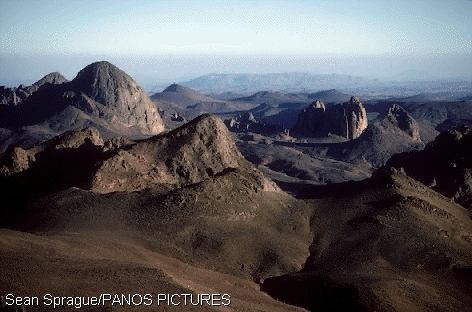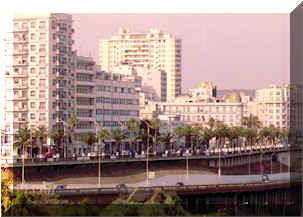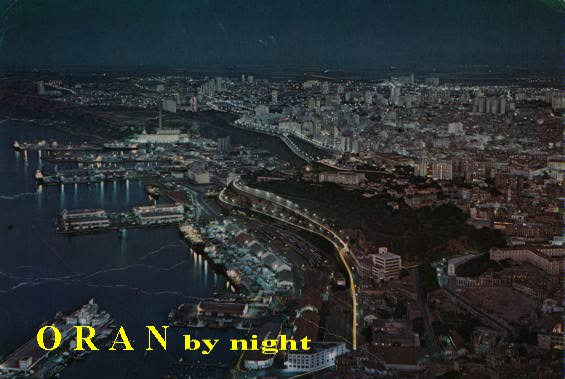
National hymn of Algeria Algeria
Officially democratic and popular Algerian Republic, State of the Maghreb, edged to the north by the Mediterranean Sea, to the East by Tunisia and Libya, to the southeast by Niger, to the southwest by Mali and Mauritania, to the west by Morocco, and notably the western-Sahara.It's the second country of Africa by its surface - 2 381 741 km2, but the 4/5 are occupied by the Sahara. The capital of Algeria is Algiers.
Natural habitat Algeria has two big geographical wholes: chains of the Atlas, in the north, and the Sahara, in the south. Between massifs of Atlas tellien, or Algerian Tell (Kabylie, Mascara, Ouarsenis, Saïda, Tlemcen, etc.),stretches a narrow and discontinuous plains. Climate In the north, the climate is typically Mediterranean. Summers are hot and dry, the winters are soft and
humid (400 mms to 1 000 mms of rain per year). The middle temperatures (25!°C in August and 12!°C in January in Algiers) vary according to the altitude. In summer, the sirocco(which breaths from the Sahara)are extremely hot and dry wind. On the High Trays and in the Atlas of Sahara , precipitations decrease (200 mms to 400 mms per year). In the Sahara, they are lower to 130 mms per year. The
thermal amplitude is very important (from 49!°C the day to -10!°C the night). The aridity of the climate is accentuated by the winds of sand and sometimes it's very violent (simoun).
Population and society In 1995, Algeria counted 28,8 millions of inhabitants, which means 12,1 inhabitants/km2. However, this number reflects an unequal distribution: we appraises that 96% of the population live on 17% of the territory, essentially in the north of the country.
Administrative carving and main cities On the administrative plan, Algeria has 48 wilaya, divided in 160 daira (under-prefectures) and 1 541 townships. Arts and cultural life As political capital, Algiers is the cultural capital of the country. The national Library posseses one of the richest funds of the country (650 000 volumes), containing important works on Africa. The library of the
university of Algiers shelters more than 700 000 volumes. The museum of the Prehistory and the Ethnographie, the national classic and Moslem Antique Museum and the national Museum of Fine arts are all in Algiers. The museum of Cirta, to Constantine, has collections of art and archeology. Heirs of an ancient tradition, the Algerian writers knew to maintain the wealth of expression of the Arabian language literature while associating to it the French language. the contemporary Algerian
literature forged itself from a double influences that confers its oddness. *: © & (p) 1995-1997 Microsoft Corporation. All rights reserved . Life in Sahara 
The massif of the Hoggar: The extents desert of the massif of the Hoggar stand in the Sahara, to the
southeast of Algeria, where torrid temperatures, often reach the 50°C. The most elevated altitudes of the country are in the Hoggar, to the pick of the Tahat mount that culminates to 3 000 ms. to the west of the massif, a sterile stony desert spreads on Algeria and prolong itself in Mali. 
Sean Sprague/PANOS PICTURES © & (p) 1995-1997 Microsoft Corporation. All rights reserved . ORAN: My city
(in Arabic Warhan), city of the northwest of Algeria, chief-place of the wilaya of the same name, on the gulf of Oran. It is a very active harbor and a commercial and industrial center for the country, with, in head of its exports, plastic, chemicals, wine and food products. Resources of natural gas are routed until Oran by pipelines. The big citadel of Santa Cruz, constructed by Turks (ottomans), the big mosque (1796) and
the Casbah testifie its past. Oran is a city of universities : university of Oran (1965), university of sciences and technology (1975)!;It possesses, besides,the institutes of music, dramaturgy, meteorology and telecommunications. 
Oran was founded presumably in the beginning the X century by the Moslem andalous and became an
important center of commercial exchanges between Africa of the North and Spain of the Maureses, then a den of pirates after their departure, in 1492. Spanish installed themselves in the XVIII century and built the strong part of Santa Cruz. In 1790, the city was ravaged by an earthquake. Oran was annexed by France in 1831 and knew a new economic flight. French left the city at the time of the war of Algeria (1954-1962). Population (1987) : 610 382 inhabitants. 
|
